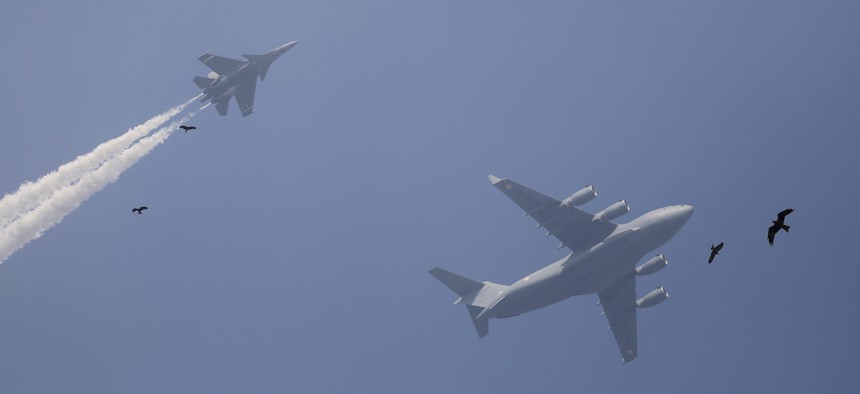
Birds fly past as Indian Air Force Sukhoi fighter jet, left, and Indian Air Force C-17 Globemaster display a fly-by during the rehearsals ahead of annual Republic Day parade in New Delhi, India, Thursday, Jan. 18, 2018. AP Photo/Altaf Qadri
How to Keep the US-India Defense Relationship Moving Ahead
Both countries can help each other in a rapidly changing Asia — if they can pick their way past several looming obstacles.
For the United States and India, a strong defense partnership is one of very few strategic opportunities in a rapidly changing Asia. Yet despite their strong commitment to the relationship, leaders in Washington and New Delhi risk letting it become an underperforming asset for both countries.
Positive steps like avoiding secondary sanctions on India over Iran or Russia and adding India to the top-tier U.S. list of “Strategic Trade Authorization-1” partners can leave officials sanguine about their ability to handle bilateral bumps in the road through calm collaboration, but the partnership needs to move beyond avoiding problems to maximize its strategic value.
India faces the growing political, economic and military power projection of China with little chance to catch up for a generation or more. China’s unprecedented “belt and road” infrastructure investments create a quandary: The resources are sorely needed by India’s neighbors, but India can offer no alternative to Chinese cash and loans. New Delhi resists Chinese-built shipyards, roads, and energy infrastructure because they provide access to the Chinese armed forces and closely bind recipients to Beijing. Sri Lanka, for example, had to cede control of the Hambantota port to China just to ease the crushing debt burden it had taken on – from China. India cannot stop neighbors from getting into such debt traps. It can, however, build a robust partnership with the U.S. as a strategic hedge against any future Chinese aggression.
Strong American alliances with Japan, South Korea, Australia, and New Zealand are not sufficient to shape the region’s trajectory without India, which could be the critical western edge of a constellation of responsible powers. But India still punches far below its weight due to massive capability shortfalls. It is in America’s interest to ramp up support for India’s defense capabilities and speed India’s modernization to balance China and shape the region even when U.S. and Indian policy views sometimes differ.
The United States and India can help one another maintain positive relations with a rising China without playing the fool should Beijing’s intentions turn hostile, but only with a focus beyond crisis management.
Congress provided a narrow path to avoid sanctioning India under the Countering America's Adversaries through Sanctions Act, or CAATSA, an important U.S. tool against Russian aggression that garnered overwhelming support in the U.S. Congress. The fix in the 2019 National Defense Authorization Act would, if signed by President Trump, provide more flexibility granting waivers to countries the President certifies are “cooperating with the United States Government on other security matters that are critical to United States strategic interests.”
This way out of sanctions does little to address India’s long-term dependence on Russia for significant materiel. Delhi has no alternative to Moscow for strategic systems, including intercontinental ballistic missiles and missile defense. Soon after the U.S. postponed the inaugural "2+2" meeting of foreign and defense ministers for a second time, India’s Defense Acquisitions Council confirmed plans to buy Russian S-400 missile defense systems, highlighting the structural challenges to strategic cooperation. Offers of U.S. missile defense systems like THAAD or Patriot to India will likely come too late to prevent an S-400 buy. U.S. systems also would not integrate with India’s other Russian and Soviet-era systems.
Beyond CAATSA, U.S. sanctions on Iran could yet ensnare India. During the last round of Iran sanctions, India quietly complied, reducing Iranian oil to just 6 percent of total imports. Today Iran accounts for 18 percent of India's oil, and unlike the earlier round, the new sanctions stem from a U.S. policy India does not support: withdrawal from the Iran nuclear agreement. If India decides it must comply under duress, the bilateral impact will be chilling.
India has played coy with the Major Defense Partner designation first made in 2016, seeking the technology and industrial advantages while downplaying the strategic benefit to India. Formal U.S. proposals like technology transfer, joint manufacturing, and co-development of future versions of the Javelin anti-tank guided missile have hardly advanced. The Lockheed Martin offer to manufacture F-16s in India for global export has not given the company a major leg up in the pending repeat of India’s major fighter jet competition. The purchase of at least 110 fighter jets could go to Lockheed or Boeing (F/A-18 Super Hornets) or to Russian MiGs, French Rafales, Swedish Gripens, or Eurofighters.
To keep on track, India and the United States should do the following:
The rescheduled 2+2 dialogue, now tentatively planned for September in New Delhi, should focus on a roadmap for substantial strategic cooperation. The agenda should include managing collateral damage from sanctions and trade disputes, including concrete steps to increase trade under the new strategic trade designation; long-term cooperation on regional security, including joint operations; and expanding defense ties into missile defense and submarine cooperation. Continuing to focus on avoiding crises will prove insufficient. Following the 2+2, each country should take some complementary steps.
The United States should assume greater risk in technology sharing with India, and India should take up more U.S. offers. India is now a party to three of the four global non-proliferation regimes, including the Missile Technology Control Regime, largely thanks to advocacy by the United States. The time has come for the U.S. to see sharing sensitive technology with India as lower risk than having India procure its most sensitive systems from Russia.
The Major Defense Partnership status is unique to India, and it should result in unique mutual benefits. Good progress under the Defense Trade and Technology Initiative has been ongoing, with a recent dialogue continuing even after the 2+2 got postponed. Sales of P-8i Orion aircraft and unmanned Sea Guardian drones in recent years mark progress. They should not mark a historic high point. Any U.S. fighter – including the F-35 – and any missile defense system that America sells to allies – including THAAD, Patriot PAC-3 and Aegis – should be available options if India wants to pursue them.
India in turn should develop a plan to phase out Russian systems at all but the lowest end where strategic issues are minor (like Kalashnikovs) and the highest end where changes are difficult (like BrahMos and other missile systems). For everything else, a plan to build a strategically coherent and interoperable joint force is paramount to India’s security, and it should center on systems that are easy to use alongside the U.S. and NATO.
Together, both countries should to do more with a wider array of friendly partners. India should embrace active defense cooperation with the U.S. allies and partners in the Indo-Pacific rather than constantly vacillating (for example on whether or not to include Australia in naval exercises with Japan). The United States should also offer more cooperation with Central Command and with Gulf partners to help India be the critical link between that region and the Pacific.
Finally, both partners should acknowledge that putting up with frustrations in the relationship is worthwhile because of critical and shared strategic benefit, not just arms deals. Speaking at India’s 2018 Defense Expo, U.S. Ambassador to India Ken Juster said, “I firmly believe that, for there to be a peaceful, stable, and secure Indo-Pacific, we need to have a strong U.S.-India defense relationship. That sends a signal of strength throughout the region that no other relationship will.”
He’s right, but the headwinds of possible sanctions and tariffs along with old irritants like visas, trade and the lingering mistrust from Cold War differences could undermine this vital strategic opportunity if U.S. and Indian leaders are not proactive with deeds to back up their sensible words.
NEXT STORY: Risks Rise As US Reimposes Sanctions on Iran




